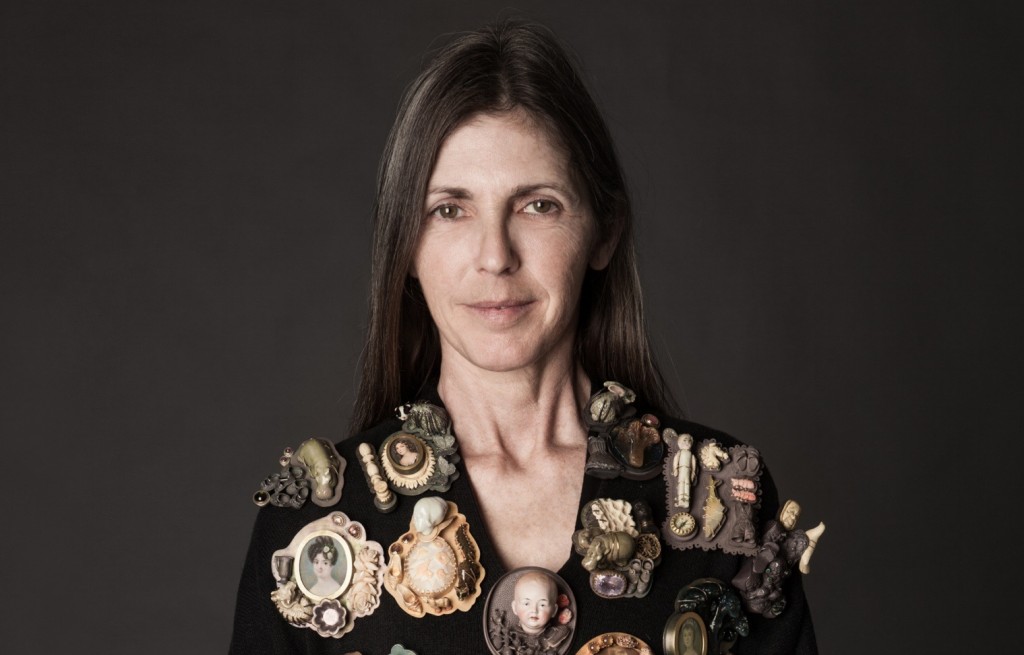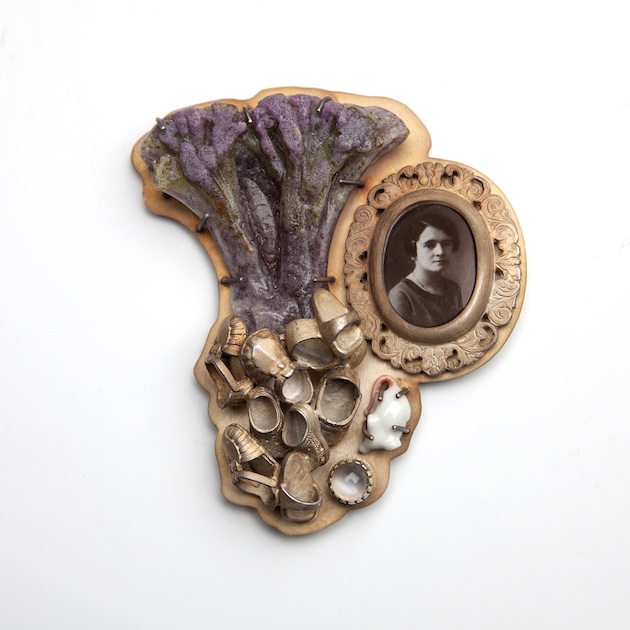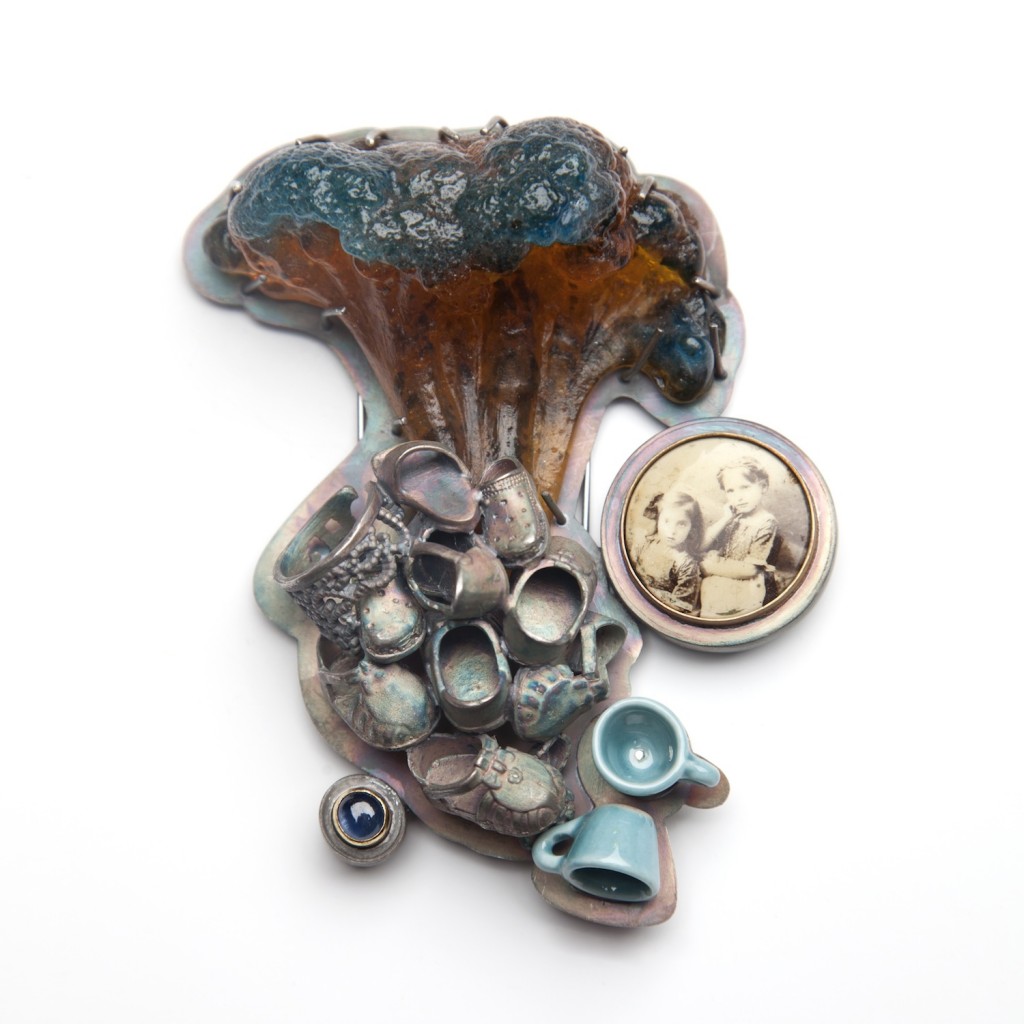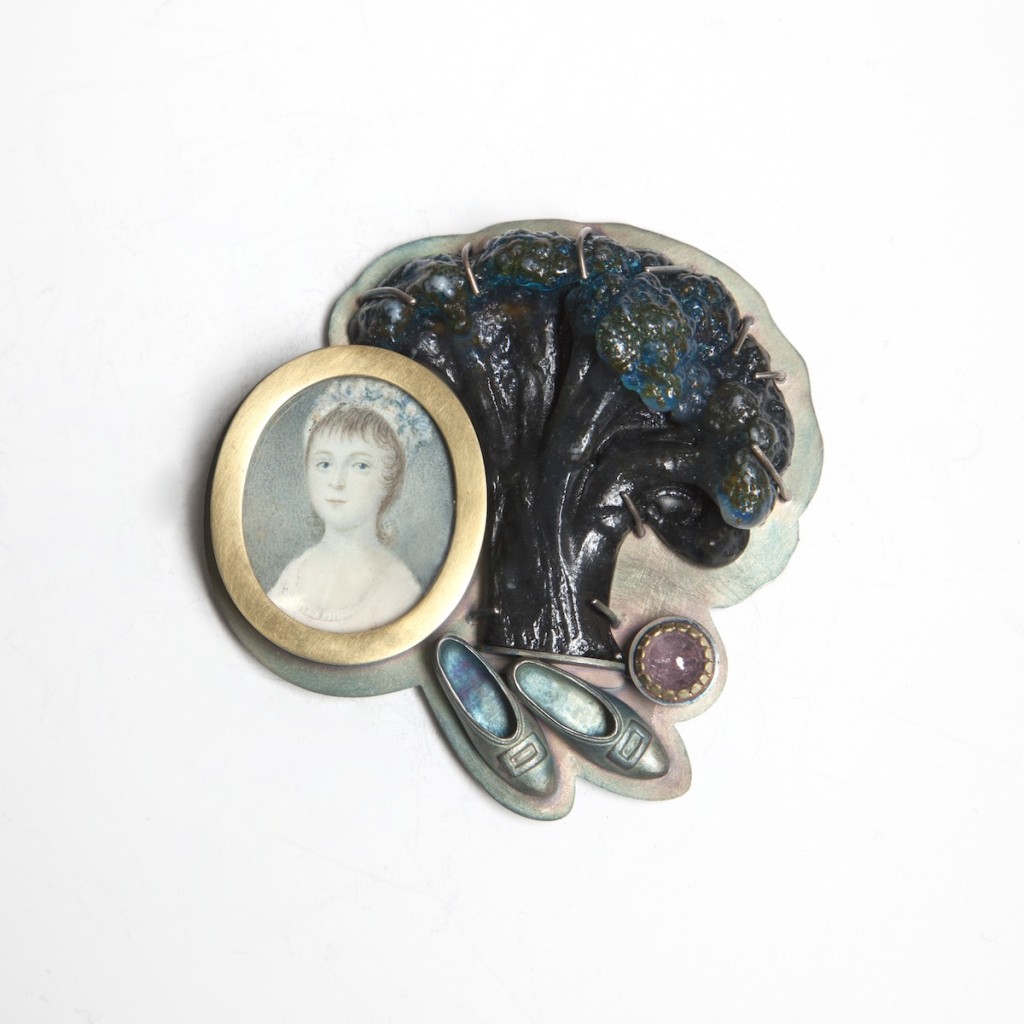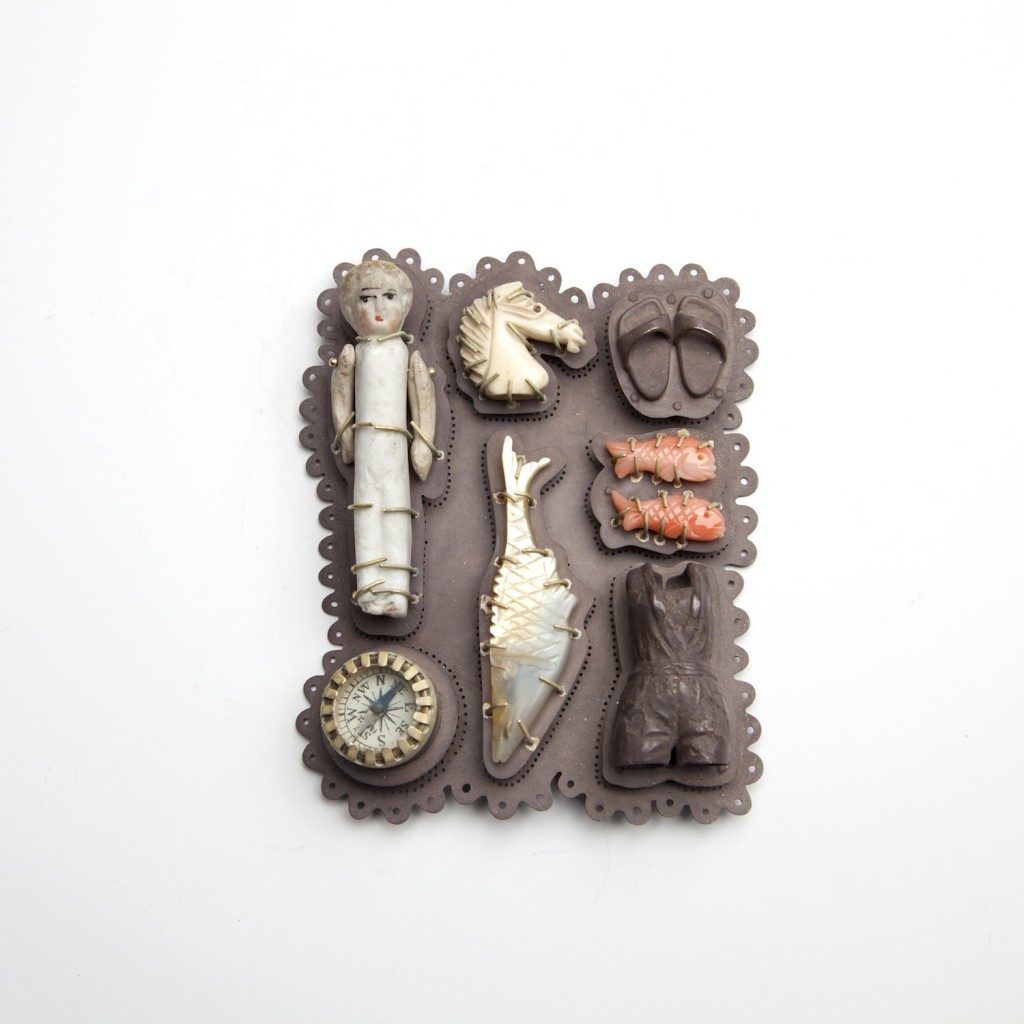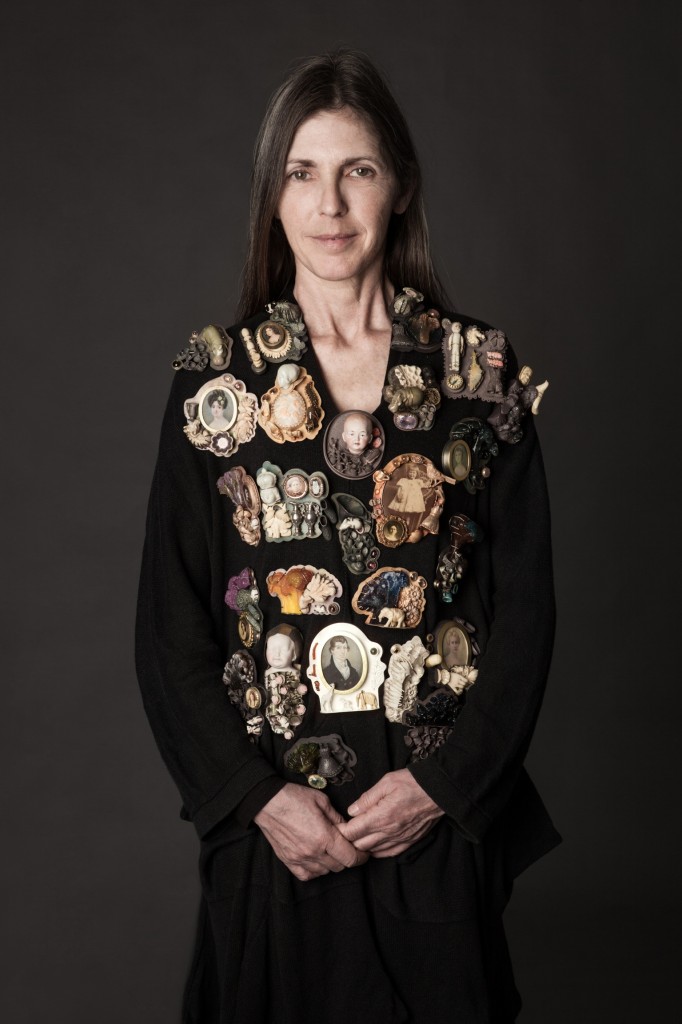In Venice, Campo San Beneto, inside a Fortuny Museum showcase (till the 14th July) there are 25 brooches . They are signed by a Venetian goldsmith (Barbara Paganin, 1961) who since the 90’s, devotes herself uniquely to the jewel.
Memoria Aperta is a large collection which follows a mighty operation of metissage: each brooch is composed of many small objects collected or found by the artist.
Barbara, in regards, says: “ I’ve a strong feeling. After many years of collecting, for the first time I’ve freed myself from being attached towards the memory taken on loan.”
Memoria Aperta begets a story, a family portrait, a whisper and at times a poem: each one of us can read it as they please, finding it bitter, very sweet, romantic or sensuous. The craftsmanship of the small lightweight sculptures is extraordinary. A castle of gestures, of tremendously precise joints and quality arrangement, as though every minute part of the brooch were a character, that talks and contributes in shaping the meaning. Barbara’s work is found in the most important museums around the world among them at the Cooper-Hewitt (New York), at the Musée Des Arts Décoratifs (Paris), at the Boijmans van Beuningen (Rotterdam).
Her jewels are landscapes, architectures, worlds: within them the protagonists are often natural forms (anemones, cauliflowers), but I think above all Barbara’s creation feeds itself through an enormous lasting love for colour: when she was younger she loved them all for the exception of blue (and it was literally impossible to be physically in proximity of it).
After completing her studies, she starts working as an illustrator at Venini’s, and each time she can is heading to the furnaces (all still open then) to breathe the magic of the molten glass and the colour that is brought into existence. Her eyes sparkle, her angular and harmonious physique tenses up when she thinks about it and describes the Murano years, the convincing voice insists underlining the importance of the process that continues to bewitch her: “With glass particles you have to feel within the colour, not just by looking at it. With glass, the colour of the glassy paste you use isn’t what you’ll see once dry. My experience with Venini was important. The flavour, the taste of the furnace…Those were the years of De Santillana, of Toni Zuccheri.”
Where do you find inspiration?
I went to Venice art college, decided to study goldsmith because I liked it, my dad read architecture at university and I wanted to copy him a little. I liked the way the word goldsmith sounded, I didn’t even know what I’d find. My mum was adopted and we know her own mother was from Montenegro and often we’ve daydreamed that this flair of mine comes from afar, maybe they were gypsies and therefore goldsmiths and I might have taken from them.
Over time you’ve experimented all kinds of techniques…
Glass entered strongly my life when I took part at the Trieste Contemporanea (2006), won it and the prize was the realization of my project (it was at that time I got in contact with Paolo Cenedese and with the school of Glass “Abate Zanetti”). Then I was offered a contract for a year and was able to make all my cauliflower moulds and did all sorts of other experiments. With glass you work with colour, it’s easy to use one, much harder mixing many, I managed utilizing up to seven, matt and transparent together.
You are among the collections of important museums. What items have you in each one of them?
At the Boijmans I have a comb, in this case, the Marzee gallery of Nijmegen had asked its artists to make a special comb to celebrate ten years of business. I made three different kinds with the possibility also to be sold, one of these the museum took.
At the Cooper there’s an anemone bought through a New York art dealer. In Paris there are two pieces: one is from the jewels of the ocean and anemone period, then a necklace with modular elements, called nasse.
The most unusual jewel you’ve made?
A charm, one makes few of those. Always for the gallery in Holland, where the art dealertripped over. To celebrate her recovery, an exhibition was organized showcasing only charms. I made a bird in gold on a square base in green silver: the base is the symbol for Earth, while the bird is lightness.
Have you ever made menjewellery?
Recently I made men’s size, huge, for several rings. I’ve always had men among my clients, also Italian, therefore my jewels are absolutely unisex.
You talk about a borrowed memory the moment you lay down this collection, are you still able to recognize the single pieces?
At a distance I’ve a global view, when close I recognize each part. You know, I also recognize them by the numbers, if you say to me 18 I can tell you which one it is and all that it came from! It’s funny, this project came about by chance. I made a single brooch and I wore it during a fair, the Collect at Saatchi (London), and all were left quite impressed. The curator of this exhibition, in particular, asked me to make several pieces to propose to the museum. I made two or three, then we got to 25 because on my way home on my bicycle, I injured one of my hands, I was worried what the outcome would be. Forced to rest, I started planning and in the end was able to make many more, even more than the ones you see here. I don’t predict selling them for they’ll be doing allot of moving around various museums after Fortuny. Once the exhibition cycle ends they’ll be on sale. I find it hard thinking about one going one direction and one the other, it’s hard thinking about separating them.
Your story in 10 lines: you were born in Venice and you’ve stayed as much as possible near Venice while your jewels wander around the world. Why?
No, there’s no reason. I’m so fond of Venice that when I left, in 2002 because I had to change home, I cut my hair to zero. Then again I’m well in many places and also when you’ve family here, many animals (at the moment 3 parrots and a cat) it’s hard to move. Now I’m in Oriago: once I had to leave Venice, any place would do. You can see more here if you want to buy the shampoo that I use.
I graduated in sculpture at the “Accademia di Belle Arti” here in Venice. I’ve taught for over 30 years, in 2002 I also ran a master class at the Royal College of London. I teach design besides jewel design, I’m interested in the methodology that is needed to make a jewel but also a suitcase. Design, in general a method (as well as enthusiasm and the will to do) are very useful for the new generations. I still find students worth teaching to. They look up to you when they know you’re passionate, that you’re not talking nonsense.
What sort of people do you meet when working as creator?
When about, I meet other goldsmiths, especially foreigners.
What sort of difficulties do you encounter as an entrepreneur?
The difference between the price of my work and the one, doubled, with which it’s sold in the galleries. After all, given what they end up costing, I could’ve given it away, for what I’m left with, after expenses and tax, is not much.
What has society done for you?
Institutions such as Fortuny Museum, where we are now, are important. Even when I won the prize Bevilacqua la Masa, it’s something the city of Venice has done for me, not only. Society for me is all that exists which one uses as a citizen: from the library to the cinema. These are gifts that alone one couldn’t find.
What have you done for society?
Create things that would otherwise only stay in my head (and others wouldn’t be able to see). The artist is a creator, like a poet that writes his poetry: a continuous gift to others.
Something beautiful that has recently happened to you?
As an artist, knowing that my pieces are bought also at Lacma (Los Angeles), through a collector drawing up an inheritance: it wasn’t a cold affair with this museum. They wrote to me, they asked about my work. It’s not like other museums when buying your work they almost don’t even tell you.
Your culinary passion and your favourite drink?
Boiled shrimps, stir fried with rice and vegetables as my boyfriend used to cook. I don’t drink, only water and teas, herbal and fennel.
The music you listen to at the moment and a book?
Given I have no time to read, I love to listen to audio books. Now I’m trying to listen to “War and Peace”, I’ve heard many in this way while I work. At the moment I listen to ‘Placebo” and the Armenian Serj Tankian. I’d say I prefer rock.
Your next projects?
A project for rings in titanium and diamonds (they won’t be single pieces like these brooches but multiples). Titanium is a very difficult metal, beautiful, light and resistant and the grey, I like so much, is fascinating. A material hard and long-lasting, solid. Steady. It’s the first time they’re assembled together, titanium and diamonds.
Artists to look out for in contemporary jewellery either precious or semi-precious?
The material isn’t important. You use the material that is congenial to transmit you’re idea (often I also use plastics). As for the young designers I’m not that clued up, there are hundreds, nevertheless I can’t say I’ve found any strong identity (they seem to copy). I know better my peers, however here in Venice there aren’t any goldsmiths. I really appreciate Babetto and Pavan, from Padova. I’m really attached to Nel Linssen, who makes paper jewellery; to the young Estonians, who use elements taken from nature (birds, butterflies, branches): things very distant from me, that’s why they fascinate me.
And your galleries? How is it going with those your working with at the moment(Paula Crespo, Lisbon; Caroline Van Hoek, Brussels; Galleria Orfeo, Luxemburg, editors note)?
I’ve stopped working with many galleries in these years because I don’t like the way they treat the pieces (they use them, wear them) or else they’ve so many, they aren’t able to show yours (what’s the point keeping them there in a drawer) I’ve only kept three galleries, one sells absolutely nothing but I’m fond of it. In Italy there are very few, anyway, I can’t keep up with their demands. Teaching means a lot to me because it has a rule, it spells out your day. After comes all the rest.
Translation by Paolo Witte
